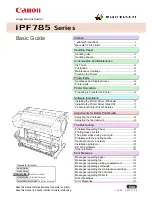
9
17.
The following security-relevant windows are available from the Local User Interface with System Administrator login and
authentication. These windows provide standard system configuration or job management capability:
•
Reset UI to Factory Settings
– Allows the System Administrator to reset the Local UI to its factory-default settings. Is
accessible by selecting the following screens/buttons in order: [
Machine Status
] hard button
Æ
[
Tools
] button
Æ
[
Device
Settings
] button
Æ
[
Reset UI to Factory Settings
] button.
•
Host Name Keyboard
– Allows the System Administrator to specify the IP host name used by the device as part of the
Quick Setup Home process for setting up the device’s IP address. Is accessible by selecting the following screens/buttons in
order: [
Machine Status
] hard button
Æ
[
Tools
] button
Æ
[
Device Settings
] button
Æ
[
Quick Setup Home
] button
Æ
[
IP
Address Settings
] button
Æ
[
Next
] button
Æ
[
Next
] button
Æ
[
Get IP Address from DHCP Server
] button
Æ
select the
‘Host Name’ text box.
•
Paper Size Preference
– Allows the System Administrator to set paper size preferences displayed by the device. Is accessible
by selecting the following screens/buttons in order: [
Machine Status
] hard button
Æ
[
Tools
] button
Æ
[
Device Settings
]
button
Æ
[
General
] button
Æ
[
Paper Size Preference
] button.
•
IPSec
– Allows the System Administrator to disable the IPSec security feature from the Local UI. Is accessible by selecting
the following screens/buttons in order: [
Machine Status
] hard button
Æ
[
Tools
] button
Æ
[
Security Settings
] button
Æ
[
Image Overwrite Security
] button
Æ
[
IP Sec
] button.
•
Job Deletion
– Allows the System Administrator to determine who has permission to delete a job from the queue at the
Local UI. Is accessible by selecting the following screens/buttons in order: [
Machine Status
] hard button
Æ
[
Tools
] button
Æ
[
Security Settings
] button
Æ
[
Authorization
] button
Æ
[
Job Deletion
] button.
•
Embedded Fax Settings – Fax Setup
– Allows the System Administrator to enable or disable the embedded fax feature. Is
accessible by selecting the following screens/buttons in order: [
Machine Status
] hard button
Æ
[
Tools
] button
Æ
[
Service
Settings
] button
Æ
[
Embedded Fax Settings
] button
Æ
[
Fax Setup
] button.
•
Embedded Fax Settings – Fax Country Setting
– Allows the System Administrator to change the country setting for the
embedded fax modem. Is accessible by selecting the following screens/buttons in order: [
Machine Status
] hard button
Æ
[
Tools
] button
Æ
[
Service Settings
] button
Æ
[
Embedded Fax Settings
] button
Æ
[
Fax Country Setting
] button.
18.
The following windows are available to any authenticated and authorized user from the Local User Interface. These windows
provide standard machine services or job management capability:
•
Embedded Fax Batch Send Confirmation
– Allows a user to either send an Embedded Fax job to a remote destination
immediately or include the job as part of a “batch” of Embedded Fax jobs sent to the same destination. Is accessible by
selecting the following screens/buttons in order: [
Services Home
] hard button
Æ
[
Fax
] feature button
Æ
[
Start
] hard
button when a user is submitting an Embedded Fax Send job to the same destination as a previously submitted “delayed
send“ Embedded Fax job.
•
Workflow Scanning Authentication Required
– Allows a user to enter the proper user credentials for a workflow scanning
job being sent to a network destination that requires user login. Is accessible by selecting the following screens/buttons in
order: [
Services Home
] hard button
Æ
[
Workflow Scanning
] button
Æ
[
Start
] hard button when a user is submitting a
workflow scanning job to a network destination that requires user login
Æ
[
OK
] button.
•
Pausing an active job being processed by the device
– Allows the user to pause an active copy, print, workflow scanning,
scan to email, Internet Fax or Embedded Fax job while it is being processed. Is accessible by selecting the [
Stop
] machine
hard button while a job is being processed by the device. Depending on the type of jobs being processed by the device when
the [
Stop
] button is selected, one of the following
Pause
windows will be displayed as appropriate to allow the user to
determine whether to delete or continue processing of the job:
Scanning Pause
window,
Printing Pause
window,
Copy Only
(Scanning and Printing) Pause
window,
Scanning/Printing (Simultaneous Jobs) Pause
window,
Scanning Build Job
Segment (No Printing) Pause
window,
Printing
Build Job Segment (No Scanning) Pause
window or
Scanning
Build Job
Segment/Printing Another Job Pause
window.
•
Overwrite Security Failure
– Automatically provides an error message to the user is case an Immediate Image Overwrite of
a copy, print, workflow scanning, scan to email, Internet Fax or Embedded Fax job fails. The error message informs the user
to notify the System Administrator that an On Demand Overwrite should be run and persists on the Local UI screen until
either a manual or a scheduled On Demand Overwrite is initiated.
•
Custom Services
– Provides access to any custom services (Third Party applications developed with a common API to run on
a Xerox device) that are installed in the device. Is accessible by selecting the following screens/buttons in order: [
Services
Home
] hard button
Æ
[
Custom Services
] button. The user then selects any of the installed services listed on the
Custom
Services
screen which will cause that service to be run. The user should be aware of the following:































